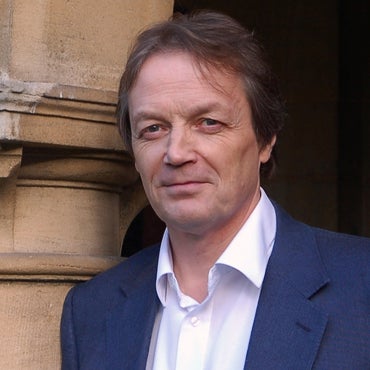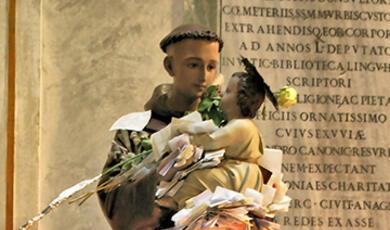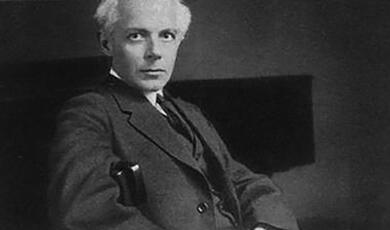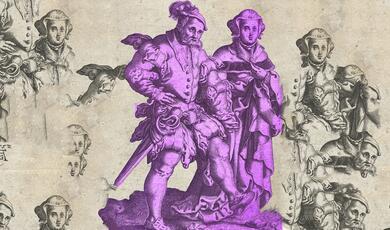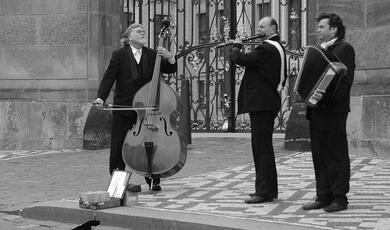Roman Singing and its Influence Across Europe
Share
- Details
- Transcript
- Audio
- Downloads
- Extra Reading
Amidst the increasingly material penury of the early medieval world, Rome and Byzantium (that is to say New Rome, now Istanbul) offered a continuing example of opulence and luxury that was expressed in worship with expensive textiles, precious metals and sonorous titles of office, including now the singer or cantor, that proclaimed supreme honour and eternal victory through liturgy. In the Western kingdoms, to maintain rich services, with a staff of good singers, was one of the ways in which a king came into his inheritance as surely as moving into the old governor’s palace. In this lecture we shall explore what the singing of Rome meant far afield: in northern England, Ireland, Spain and Germany.
Download Transcript
19 January 2016
Roman Singing and its Influence Across Europe
Professor Christopher Page
The pope, you might say, is really nobody very special. I am not saying that to placate the wandering ghost of John Rogers, once the rector of this church, who was martyred for his protestant faith in the reign of Queen Mary. I am simply describing the situation as it was, many hundreds of years ago, in Christian Europe. As everybody knows (or used to) the word pope is derived from papa, meaning ‘father’ or ‘daddy’, and in the early centuries of the Church a bishop anywhere in the Latin West might be called a pope: a holy ‘father’. Yet the meaning of the term was rapidly narrowed to mean the bishop of Rome alone.
So we begin with what Rome, the eternal city, meant. In the Early Middle Ages, it was difficult to deny the claim that Rome marked the Western extreme that the first apostolic missions were able to reach. The record of Paul’s travels to the city, his extensive letter to the Christians there, and the tradition that Peter was martyred on Vatican Hill, left little room for an alternative account. (Some of you may remember the day in the summer of 1968 when Pope Paul VI announced that bones, claimed to be those of St. Peter, had been discovered under the basilica). Rome, situated more or less in the middle of the Italian peninsula, dividing the Mediterranean into two maritime zones, east and west, was the natural bridgehead for the advance of the faith into the Western Empire. Just as Acts of the Apostles identifies ‘visitors from Rome’ amongst those in Jerusalem at the time of Pentecost, so the apocryphal Acts of Peter, probably of the later-second century, describes how Peter travelled to the Rome on a trading ship, then preached in the city until he suffered martyrdom there.
In a letter of the year 411, Pope Innocent I shows what all this had come to mean. He presents a sweeping vision of the Christian West as a Roman colony established under the direction of Peter. I quote:
It is plain that in all Italy, the Gauls, the Spains, Africa and Sicily, and the islands lying between, no churches have been founded save those where the venerable Apostle Peter or his successors established bishops. Let them seek in their records whether any other Apostle can be found for these provinces, or is said in book to have taught there. If they do not read that (for it can in no place be read) it behooves them to follow the faith of which the Roman Church is the guardian, and from which their churches undoubtedly take their origins…
Innocent writes as arbiter of the true faith for his western patriarchate, and with due confidence that many churches had good reason to accept his account to establish a place in the genealogy of apostolic and later missions.
The surviving letters that the early popes wrote to western bishops and kings show the Roman prelates reacting to news of heresy, conferring blessings, supplying collections of ecclesiastical law upon request and answering questions about clerical discipline in crisp and legal language – very much a Roman voice. It is extraordinary to read these letters and imagine what lies behind them: the couriers leaving Rome, crossing the Alps or taking ship to Marseille; their retinues coming onto the grasslands of northern Europe where butter replaced olive oil, and where beer competed with wine, to reach Rouen, perhaps, or Paris or Metz. There they would find the realms of barbarian rulers (Franks, Burgundians, Goths and others) who were all, in Roman eyes, either marauders or caretaker governors subject to imperial authority; in their own eyes, of course, they were kings, with only the most residual notion that they might be children in the family of an imperial father in Constantinople. The popes maintained a high level of correspondence with consistently far horizons, and they used their letters to fashion a Roman obedience in the Western churches. An example from the year 404 shows Innocent I once more, this time writing to a bishop of Rouen, the prelate on the river Seine whose city had only just ceased to be an important collecting point for military supplies to Britain, now abandoned. The matters discussed in the letter include sexual continence, the criteria for admission to the ranks of the clergy and advice for dealing with clerics who seek public office. One provision in the letter requires that Rome should be consulted in all weighty matters, especially including disputed questions of doctrine. For this pope, the fundamental matters discussed in this letter, concerning the governance of clergy and laity, are quite simply Romae disciplina: the teaching of Rome.
Was Roman singing part of this Roman teaching? To put it very simply, even crudely: Did bishops in far-flung dioceses want their singers to sing like Romans? This is a wonderfully complex and fascinating question for we are dealing with a time when politics and religion were not separate domains. Uniformity of worship across different dioceses was deemed to express and indeed promote political unity within a kingdom. When a rite was shared between kingdoms the realms shared something that combined what we think of as an alliance, a treaty and a declaration of friendship, to which we should add a sharing of the peace of Christ. So the answer to the question (‘did bishops in far-flung dioceses want their singers to sing like Romans?) is essentially yes, but not at once, and not everywhere. Before we look into that, I would like you to hear some of the earliest recoverable chant from Rome. It seems to me, and I would be very interested to hear your views on this, that this music strongly suggests that a tradition of improvisation lies not far behind it: I mean a practice in which the cantor compiles music on the spot from elements, learned during his apprenticeship, that provided him with pre-shaped melodic ideas, with ways to mark a pause in the sense of the text with a melodic turn of the appropriate weight, and so on
Puer natus
That was a Roman chant, Puer natus est nobis, written down in the eleventh century. The scribe used what was then the relatively new technique of writing music on a staff, the system we still use. (See handout). I shall come to that in the last lecture of this series. But what is the music you just heard? The current term for it is ‘Old Roman chant’, and it comes from the earliest decipherable repertoire of liturgical music used in Rome. How is it related to other European chant, especially what is popularly known as Gregorian chant? That remains one of the most controversial issues in the history of music, and the fact that modern scholars generally call the Gregorian music ‘Frankish-Roman’ chant will give you some idea how complex the ancestry and intermarriage of these great Western repertories may be.
One thing is clear, however: throughout the western kingdoms the worship of Rome was associated with a quasi-imperial dignity, and with great material opulence. In northern European lands, for example, where pepper, silk and incense had become rare luxuries by the eighth century, and where churches or royal courts were becoming islands of elite goods amidst a landscape of deepening material penury, the Church of Rome was the western outpost of a surviving Roman empire that was becoming essentially an Asian polity: or if you prefer, Byzantium.
Imagine this. The scene is Rome in the eighth century. The pope is rising in procession from the Lateran palace to the appointed church for the Mass which he will celebrate amidst the columns and mosaics of S. Maria Maggiore. Many officials of the Roman Church go before and behind him: deacons, the chancellor, notaries and others. All the people and the clergy of the Church of Rome are present, or at least they are represented. Many officials of the Church bear titles of office like primicerius notariorum (‘chief of the notaries’) with an impressively imperial and even a military flavour. Some are carrying linen cloths, others basins for the washing of hands; the subdeacon who will read the epistle carries the epistle-book, and the archdeacon the gospel-book. As the cavalcade proceeds, some give the pope written petitions as he passes. Arriving at the church, the pope changes his vestments of linen. A subdeacon calls out: ‘Choir!’. They answer, in the singular: ‘I am present’. Then he asks: Who Is going to sing the psalm? and they answer, So-and-so, and so-and-so.
In response to a sign, the choir sings an Introit that gives the pope and his clergy their cue to enter the church from the sacristy with lights and incense. When the pope gives the signal, the singers bring the Introit to a close; the Kyrie eleison follows, unravelling in performance like a roll of silk to be cut or extended as required, for the leader of the choir is charged to keep his eyes on the pope ‘so that the pontiff may signal to him if he wishes to change the number of Kyries’. The celebrant then begins the Gloria in excelsis when it is the appropriate season. Next, a subdeacon reads the epistle from a raised platform, then a cantor holding his cantatorium as a sign of his office mounts to the same place and sings the Gradual; soon, another sings the Alleluia or a Tract according to the liturgical season.
With so many interventions to make – and I have only mentioned a few of them – the Roman singers bore a heavy responsibility for the ordered performance of the service. What is more they faced a grave penalty if something went amiss. The fourth-in-command of the choir faced excommunication if the assignment of chants to individual singers, announced beforehand, was changed in any way during the course of the service so that the pope was left vainly signalling to the wrong cantor. (Notice I have just mentioned the fourth in command; that is how elaborate the hierarchy had become! A very Roman thing). Yet although the decorum of the rite owed much to the professionalism of the choir, the singers did not enjoy much prestige. The need to install them in the church before the pope’s arrival denied them any place in the cavalcade with its impressive display of liturgical books, textiles and precious plate. The most one can say for the singers of Roman choir around 700 is that their corporate identity had been consolidated to the point where they were enough of a body, even a kind of club, to answer a summons in the singular, replying ‘I am here’ (adsum) when the regional subdeacon called them at the beginning of the service.
Rome is not, in fact, the earliest place where singers can be found organised into a body with a structure of command. Your handout shows am epitaph dated to the year 525 from Mértola, a city in what was then southern Lusitania, and is now southeastern Portugal next to the Spanish border….
ANDREAS FAMVLV[S] DEI PRINCEPS CANTORVM SACROSANCTE AECLISIAE MERTILLIANE
As you can see, the inscription refers to this otherwise unknown Andrew as the leader or ‘first of the singers’ in the church of Mértola. That city lies on the Guadiana river, and it will be some time before we escape connections with the sea and major fluvial routes in our search for these early singers.
Your handout shows another early example, this time from a literary text and once again we are in a major port, for this comes from Naples, and dates from around 500:
‘Marinus…primicerius cantorum sanctae ecclesiae neapolitanae…’
Here we have the primicerius or leader of the cantors of the cathedral of Naples.
To give these tiny fragments of text a very wide context, let me direct you to the map on your handout. In a sense, it has nothing to do with singers at all; it charts the distribution pattern of a particular kind of amphora, or ceramic jar, in the fifth and sixth centuries. It was used to carry wine from Calabria and Sicily.
https://s3-eu-west-1.amazonaws.com/content.gresham.ac.uk/data/library/2017-01-19-ChristopherPage_IMG.jpg
If Naples and Mértola had already organised their singers into a body with a command structure by the 500s, then it seems very likely the Romans had done the same. Here once more it is the sheer size of the Roman establishment that weighs heavily. The basilicas, churches, monasteries, private foundations and churches without the walls of Rome formed a complex and cellular structure reaching across the city, with each cell in the body of the Church energised by its own endowments, rights and privileges. Arrangements made at any time for the training and provision of singers were perhaps liable to be scattered and difficult to centralise. There was a need in Rome, more than in anywhere else for some kind of organised recruitment and provision.
Beatus sevus quem cum venerit
Given the magnificence and influence of Rome, it comes as a surprise to find that the recruitment of singers relied on something very informal and even perhaps lowly: the care of orphans. I have been using the term ‘choir’ when translating Roman documents; the actual term is schola, whence of course our word ‘school’. It could mean many things at the time, such as a military company (a sense by no means irrelevant here), or monks living in some form of what I would call familial cohabitation. ‘I would not have the monks living in their own cells’, wrote on monastic author, ‘but let them all remain in one schola’. Any attempt to envisage the forms that an organised group of singers could take in Rome should look to the many ways in which men and women might live in some form of that ‘familial cohabitation’. This is something that has virtually vanished from modern experience, it seems to me, save perhaps in boarding schools, but there (as those who have been to public schools tell me) the affective dimension implied by the term ‘familial’ is often sadly lacking. At one extreme, this cohabitation could encompass singers who might share certain facilities such as a lodging or common chapel. At the other, it could include pupils receiving education within various kinds of charitable foundation. In other words, the history of the Roman choir belongs with many different and yet overlapping forms of cohabitation for the purposes of education, charitable care in hospitals and liturgy.
During late Antiquity, let us say between 350 and 500 for the sake of round dates, the weak and disadvantaged gradually ceased to be citizens entitled to aid in the form of imperial doles and became instead the poor of Christ. The clergy gradually began to view the Christian populations of the cities in a manner that combined imperial traditions of paternalistic care with an emphasis upon charitable provision for the weak. Already by the end of the fourth century, various forms of hospital for pauperes appear around the Mediterranean in Italy (Ostia and Rome), and in North Africa (Hippo, in the time of Augustine).
Such hospitals were often relatively small, taking their place in the cityscape of Rome where the characteristic new foundations ‘comprised a church (or chapel) associated generally with a small private monastery or with a charitable institution…’. The result may have produced a general appearance not far removed from the scenes recorded in the sixteenth century before the demolition of old Saint Peter’s, showing files of buildings that appear to be little more than small private houses in scale.
Some of this charitable provision was for children. Boys, many of them probably orphans or children vowed to the monastic life by their parents, often appear in Roman documents from the sixth century onwards as a form of ecclesiastical human capital, moved from place to place as the resources or needs of their master dictated. These boys, many of whom were undoubtedly orphans, and passing from hand to hand, were seemingly regarded as potential clergy that would eventually emerge from the many different contexts, scattered across Rome, where ad hoc arrangements had deposited them to receive some form of training.
Now ‘A place for bringing up orphans’ is one of the earliest names for a foundations that the Roman schola cantorum, the organised body of singers which becomes traceable by We have a document recording the diversion of funds to an orphanotrophium ‘lest the order of singers be wanting’. Presumably the same institution is meant when Pope Sergius II who died in 847, is credited with repairing ‘the schola cantorum, once called orphanotrophium’.
What about England? You may think my account in this lecture so far (indeed in this series so far) has been rather too keen to drink what Keats called a full beaker of the warm south. You may be right. But now we must send our imaginations to a very different world and one which, I find, it is a very moving thing to contemplate. We move to Jarrow, to Sunderland and Ripon; to Newcastle where the Roman wall runs by housing estates, to Hexham, where a stair descending from the nave of the church takes us back more than a thousand years into crypt made from stones brought from a deserted Roman fort.
In such remote parts of the Latin world it was especially difficult to sustain the rich materialism of Christian rites that were essentially Near-Eastern, redolent of cedar and incense, filtered through Roman imperial opulence of fine fabrics, marble, gold and silver to express the glory of the divine and the authority of the bishop. The Roman imperial administration, at its height, had been able to maintain excellent transalpine contacts; networks of civil and military communication brought supplies of oil for lamps and military rations, incense for the imperial and other cults, silk for hangings and cloaks, and pepper (among many other spices) to the North European Plain, even to remote places like Colchester and (more remote still) York, and more remote even than that, the fort of Vindolanda by the wall. By the seventh century, however, the Roman world-system was in disarray on a Eurasian scale. The prolific historian Gregory of Tours, who died in 594, finds no reason in his voluminous works to mention the Mediterranean ports of Arles, Fos or Narbonne, for example; he names only Marseille, suggesting that the long-distance contacts of the other ports were much diminished or even none existent. When a much greater historian, the Anglo-Saxon scholar Bede, died at his monastery of Wearmouth-Jarrow in 735, he gave out a few grains of pepper to his pupils evidently regarding it as a thing of great price.
Westerners had only to question travellers, or to undertake a pilgrimage, to find that the rites of worship were celebrated with great luxury and ceremoniousness in Rome that it was difficult to imitate in the north. The churches imported what they could. The mass-vestments at Kildare in the early sixth century, for example, were reported to be vestimenta transmarina et peregrina, ‘overseas vestments of foreign origin’ and may have been purchased in Rome; others travelled to the eternal city on merchant ships to fetch what the greatest historian of the earlier Middle Ages, Bede of Jarrow, calls the riches ‘of spiritual commodities’, spiritualium mercium. That is a potent expression, and much might be made of it. A given state of liturgy in an early-medieval monastery or church, expressed a particular state of long-distance communications and trade – or rather the strength of the determination to triumph over any impoverishments the decline of such communications were felt to be imposing.
So now let us hear the most luxuriant of the Old Roman chants that I have for you today.
Viderunt omnes
What did far distant Rome mean in a place so far from the eternal city, and so far from its markets, as Northumbria? The answer is a very great deal, as we may see from a text entitled The Life of Saint Wilfrid. This shows its hero building a church at Ripon in 671-8 with blocks of dressed stone in the Roman manner, taken from ruinous Roman buildings nearby. Wilfrid set up columns to create an interior adorned ‘with gold and silver and varied purples’, perhaps provided by textiles obtained in the markets of Rome during one of his several recorded journeys there. He ordered a copy of the gospels to be made for Ripon with golden letters on purple parchment, imitating models he had seen in Rome. On his next visit to Rome in 679-80 Wilfrid obtained relics ‘for the building up of the churches of Britain’ together with many other valuables that he purchased, and he returned from his third visit in 704 with ‘vestments of purple and silk to ornament the churches’.
From the late 600s onwards, signs of interest in the Roman chanting pick up sharply with the Anglo-Saxon soldier turned abbot, Benedict Biscop. In 674, when many churches in England were still essentially long houses constructed of wood and roofed with thatch, Benedict built a monastery of stone ‘after the Roman fashion’ at Wearmouth. Whatever else it may imply, the expression ‘Roman fashion’ certainly means large blocks of dressed stone. The house was dedicated to Saint Peter, and in 681 Benedict established a second branch at nearby Jarrow, dedicated to Saint Paul and thus completing his invitation that the greatest saints of Rome should direct their gaze to one of the northernmost corners of the Christian world. A great many miles, and a bleak expanse of the North Sea, separated Wearmouth and Jarrow from Rome; Benedict Biscop nonetheless worked hard to establish a spiritual canal between the Tiber and the Tyne where his twin houses were among the most exposed stations of the Catholic faith in the north. And they were exposed. The monks of Wearmouth-Jarrow faced a belt of pagan lands across the North Sea running down from northern Scandinavia to at least the modern Franco-Belgian border near Lille. Benedict Biscop knew what a missionary would find if he sailed round the north and eastern coast of Britain: ‘Frisians, Rugians, Danes and Old Saxons… practising heathen rites’.
Benedict Biscop repeatedly overcame the great distance that separated his monastic foundation from the papal city, undertaking six pilgrimages to assemble a library at Wearmouth-Jarrow with few parallels in the West outside parts of Italy or Seville. According to Bede, who spent his life at Jarrow reading these volumes and supplementing them with books of his own, Benedict also wanted the ‘yearly cursus of chanting’ together with ‘its ordo of rite, chanting and reading aloud’. To accomplish this, Benedict returned from his fifth pilgrimage with John, a monk and arch-chanter of Saint Peter’s basilica and abbot of Saint Martin’s. So that John might ‘teach the monks…the mode of chanting throughout the year’, John ‘committed to writing all things necessary for the celebration of festal days’
John the arch-chanter was one stream of information, so to speak, in the complex message that Benedict Biscop was bringing back from Rome with manuscripts, images and other materials. In doing so he created an outpost, a distant frontier fort, of the Christian West, and he needed a singer to do it.
© Professor Christopher Page, 2017
This event was on Thu, 19 Jan 2017
Support Gresham
Gresham College has offered an outstanding education to the public free of charge for over 400 years. Today, Gresham plays an important role in fostering a love of learning and a greater understanding of ourselves and the world around us. Your donation will help to widen our reach and to broaden our audience, allowing more people to benefit from a high-quality education from some of the brightest minds.


 Login
Login
